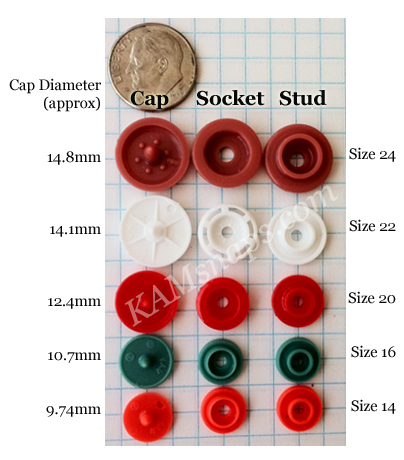It is industry standard to refer to snaps by “size” or sometimes "line" or "ligne" according to their cap diameter. However, this “size” does not correspond to any actual measurements. For example, size 20 snaps have a cap diameter of 12.4mm. It is important never to confuse a snap’s “size” with its actual measurements.

**Note that sizes 14 and 16 plastic snaps have identical studs and sockets--only the caps are different.
To convert mm to inches, please refer to this chart: http://mdmetric.com/tech/cvtcht.htm.
Plastic Snaps
| Size | Cap Diameter | Standard Prong Length | Long Prong Length |
| 14 | 9.74mm |
3.5mm |
5.0mm |
| 16 | 10.7mm |
4.2mm | 5.2mm, 6.2mm, 7.2mm |
| 20 | 12.4mm |
5.6mm | 6.2mm |
| 22 | 14.1mm | 7.0mm | n/a |
| 24 | 14.8mm |
7.5mm | n/a |
Metal Snaps
| Size | Cap Diameter | Prong Length |
| 14 | 9.74mm |
3mm |
| 16 | 10.7mm |
3mm |
| 20 | 12.4mm |
5mm |
| 24 | 15mm |
5mm |
Measurements are approximate.
What size snap should I use?
This is somewhat of a loaded question because what size is right for you depends on your particular project, the fabric you are using, the number of layers you have, and your own personal preference. Note that there is some flexibility in which size can be used. For example, if you have 4 layers of t-shirt cotton, most likely size 16 and size 20 snaps would both work.
The information below is just a general guide and may not necessarily apply to every single case:
- Size 20
is most commonly used for general applications, including baby diapers, clothing, and household projects. This is the most popular size of plastic snaps and is a
good size to start with for most projects.
- Size 16 is
most commonly used for baby and toddler clothing, mama pads, and
multiple layers of grosgrain ribbon. Because size 16 caps have shorter
prongs compared to size 20 caps, they are more appropriate for thinner
material. For example, 2-3 layers of t-shirt cotton would probably
work better with the shorter size 16 caps than size 20 caps.
Also, since size 16 sockets and studs are smaller compared to size 20
sockets and studs, they have a slightly less firm (though still firm)
grip, which makes them more appropriate for delicate fabric more easily
prone to tearing as a result of repeated snapping & unsnapping over
time, such as stretch cotton.
- Size 14
has very short prongs and should only be used for very thin material
like a single layer of grosgrain ribbon or doll clothing. Generally,
size 14 caps are so short that they're best for a single layer of thin
material. Please note however that your material may be more proned to
ripping over time if you are only using a single layer. Size 14 long prong caps would be more appropriate for multiple layers. Size 14 sockets and studs are identical to size 16 sockets and studs.
- Sizes 24 and 22 are
for heavy duty applications requiring a firmer grip, such as tote bags,
tarps, coats, and upholstery. Size 24 provides the firmest grip.
Generally speaking,
the smaller the “size”, the shorter the prong and the thinner the
fabric they should be used for. However, we also offer long-prong options for thicker projects.
To make it even
more interesting, you can also mix sizes. For example, you can use
size 16 caps with size 20 sockets & studs. This is what I
personally do with most of my projects because my material layers tend
to be thin which work better with size 16 caps, but I prefer the
stronger grip and larger size of the size 20 sockets & studs.
This can all be
overwhelming to the new user not familiar with snaps or how they exactly
work. Good sizes to start with for most applications are size 20 and
size 16. You can play around with each size as well as mix & match
them to see what best suit your needs and preferences.
If you are unsure which size you need, you may also purchase snap samples here.
For answers to more frequently asked questions, including how to install snaps, what are snaps comprised of, how snaps work, and lots more, please visit our complete Beginner's Guide.
For answers to more frequently asked questions, including how to install snaps, what are snaps comprised of, how snaps work, and lots more, please visit our complete Beginner's Guide.






2 comments:
This is a really informative knowledge, Thanks for posting this informative Information. General Prong
This is informative, but something seems to be missing.
Some places give the size as a number ("size 20"; "size 16", etc.), some give it as a measurement ("14.2mm"; "9/16 inches", etc.), and some use a letter AND a number: "T3:, "T5", "T8", "T8R", "B3", etc.
What do all these "T" and "B" sizes mean??
Post a Comment